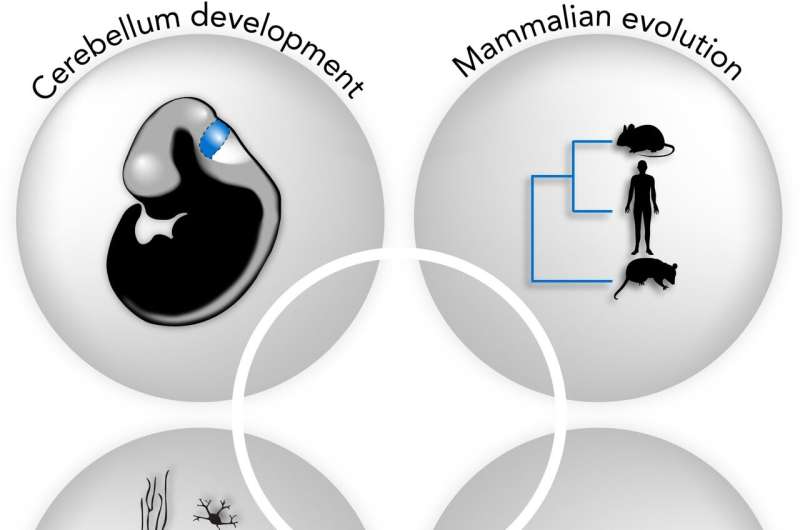Scientists unveil genetic programs controlling the development of cellular diversity in the cerebellum


The evolution of higher cognitive functions in human beings has so far mostly been linked to the expansion of the neocortex—a region of the brain that is responsible, inter alia, for conscious thought, movement and sensory perception. Researchers are increasingly realizing, however, that the “little brain” or cerebellum also expanded during evolution and probably contributes to the capacities unique to humans, explains Prof. Dr. Henrik Kaessmann from the Center for Molecular Biology of Heidelberg University.
His research team has—together with Prof. Dr. Stefan Pfister from the Hopp Children’s Cancer Center Heidelberg—generated comprehensive genetic maps of the development of cells in the cerebella of human, mouse and opossum. Comparisons of these data reveal both ancestral and species-specific cellular and molecular characteristics of cerebellum development spanning over 160 million years of mammalian evolution.
The research results were published in the journal Nature.
“Although the cerebellum, a structure at the back of the skull, contains about 80 percent of all neurons in the whole human brain, this was long considered a brain region with a rather simple cellular architecture,” explains Prof. Kaessmann.
In recent times, however, evidence suggesting a pronounced heterogeneity within this structure has been growing, says the molecular biologist. The Heidelberg researchers have now systematically classified all cell types in the developing cerebellum of human, mouse and opossum. To do so they first collected molecular profiles from almost 400,000 individual cells using single-cell sequencing technologies. They also employed procedures enabling spatial mapping of the cell types.
On the basis of these data the scientists noted that in the human cerebellum the proportion of Purkinje cells—large, complex neurons with key functions in the cerebellum—is almost double that of mouse and opossum in the early stages of fetal development. This increase is primarily driven by specific subtypes of Purkinje cells that are generated first during development and likely communicate with neocortical areas involved in cognitive functions in the mature brain.
“It stands to reason that the expansion of these specific types of Purkinje cells during human evolution supports higher cognitive functions in humans,” explains Dr. Mari Sepp, a postdoctoral researcher in Prof. Kaessmann’s research group “Functional evolution of mammalian genomes.”
Using bioinformatic approaches, the researchers also compared the gene expression programs in cerebellum cells of human, mouse and opossum. These programs are defined by the fine-tuned activities of a myriad of genes that determine the types into which cells differentiate in the course of development. Genes with cell-type-specific activity profiles were identified that have been conserved across species for at least about 160 million years of evolution.
According to Henrik Kaessmann, this suggests that they are important for fundamental mechanisms that determine cell type identities in the mammalian cerebellum. At the same time, the scientists identified over 1,000 genes with activity profiles differing between human, mouse and opossum.
“At the level of cell types, it happens fairly frequently that genes obtain new activity profiles. This means that ancestral genes, present in all mammals, become active in new cell types during evolution, potentially changing the properties of these cells,” says Dr. Kevin Leiss, who—at the time of the studies—was a doctoral student in Prof. Kaessmann’s research group.
Among the genes showing activity profiles that differ between human and mouse—the most frequently used model organism in biomedical research—several are associated with neurodevelopmental disorders or childhood brain tumors, Prof. Pfister explains. He is a director at the Hopp Children’s Cancer Center Heidelberg, heads a research division at the German Cancer Research Center and is a consultant pediatric oncologist at Heidelberg University Hospital.
The results of the study could, as Prof. Pfister suggests, provide valuable guidance in the search for suitable model systems—beyond the mouse model—to further explore such diseases.
Also participating in the studies—apart from the Heidelberg scientists—were researchers from Berlin as well as China, France, Hungary, and the United Kingdom. The European Research Council financed the research. The data are available in a public database.
More information:
Cellular development and evolution of the mammalian cerebellum, Nature (2023). DOI: 10.1038/s41586-023-06884-x
Journal information:
Nature
Source: Read Full Article